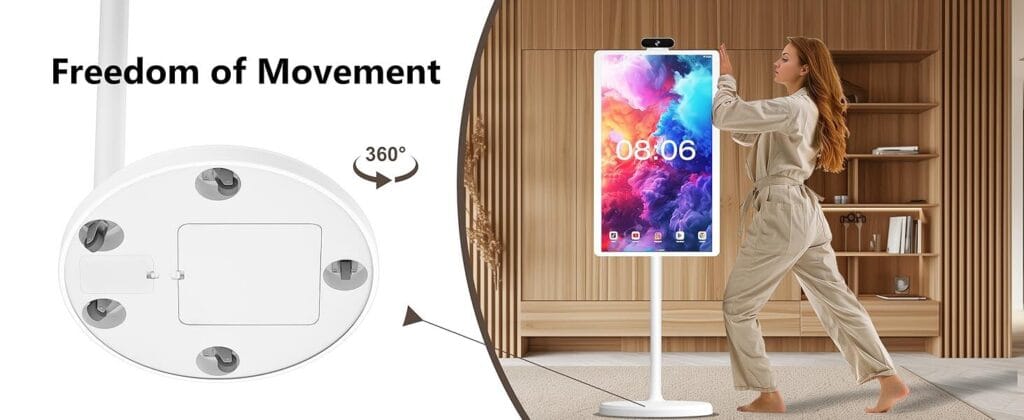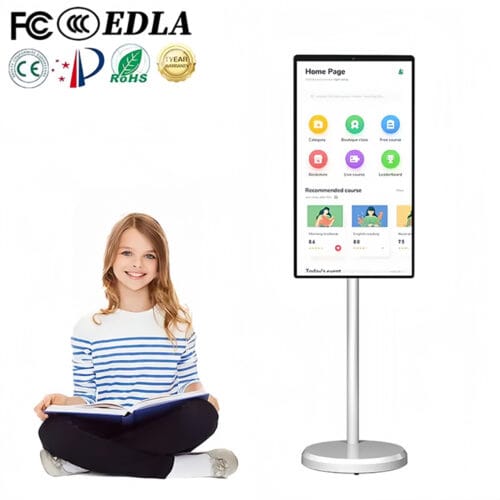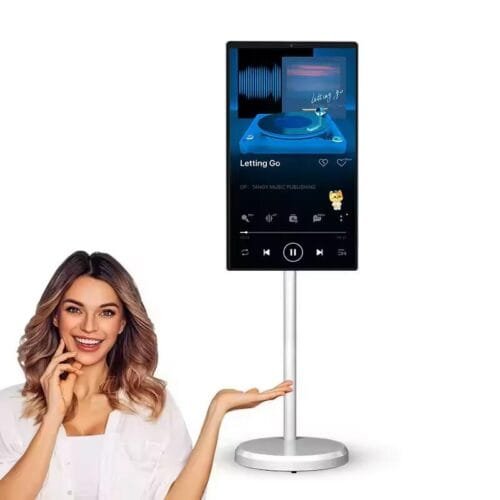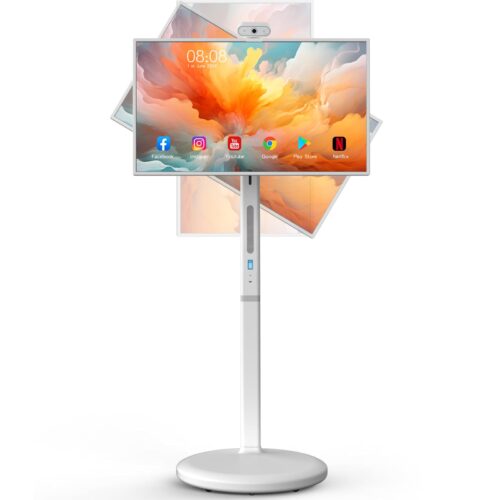In the ever-evolving world of home entertainment, convenience and flexibility have become major driving forces behind technological innovation. One of the most exciting new advancements in this space is the emergence of TV on wheels—a concept that redefines how we consume media both indoors and outdoors. These portable televisions have been designed to solve a variety of real-world problems, making entertainment more accessible and adaptable to different environments.
In this blog post, we’ll take an in-depth look at the latest TV on wheels products, focusing on their design, performance, usability, and overall market trends. Whether you’re interested in outdoor movie nights, enhancing your home setup, or finding the perfect device for professional settings, these mobile TV solutions offer an innovative experience that meets the growing demand for flexible and versatile viewing.
Let’s explore the world of TV on wheels to see how this innovation is transforming the television industry.
-scaled.jpg)
1. Design and Portability of TV on Wheels
One of the most distinctive features of TV on wheels products is their portability. These TVs have been designed to be moved easily, which is why their exterior and form factor are just as important as their internal technology. The design philosophy centers around creating a device that is not only functional but also stylish and easy to transport.
Exterior Design and Build Quality
At the core of any TV on wheels product is the design. Manufacturers have taken the portability aspect into account by designing slim, lightweight models that are easy to roll or carry. These units often feature minimalistic designs with smooth edges, contemporary finishes, and premium materials that enhance both aesthetics and durability. For example, many models have plastic or aluminum bodies to reduce weight without sacrificing sturdiness. Some devices even come with customizable casings to match your decor or personal preferences, allowing you to choose from different colors, finishes, and materials.
Size and Weight Considerations
The screen size of TV on wheels typically ranges from 24 inches to as large as 65 inches, offering a variety of options to fit different needs. For those who prioritize portability, smaller models (around 24-32 inches) are ideal for moving between rooms or outdoor spaces. These lightweight models usually weigh around 10-15 kilograms, making them easy to maneuver and set up in different locations, even by a single person.
On the other hand, larger models like the 55-inch or 65-inch versions provide a more immersive viewing experience but may be slightly bulkier and heavier. Despite their size, these larger TV on wheels are still far easier to move around than traditional stationary televisions, thanks to the built-in rolling stands or wheels that make transportation effortless.
Wheels and Portability Mechanisms
The wheels on TV on wheels products are designed for smooth mobility, allowing users to glide the TV across various surfaces without hassle. These wheels are often equipped with locking mechanisms to ensure stability once the TV is in place. The ease of movement is a major selling point for these devices, as users can quickly shift their entertainment setup from the living room to the backyard, or even between multiple rooms for various uses.
Many models are also equipped with handles or stands that double as mounting systems, providing flexibility in how the TV can be displayed or stored. The portability of TV on wheels is particularly valuable for users who frequently rearrange their living spaces, need temporary setups, or want to take their entertainment on the go.

2. Functionality and Performance
While design and portability are key aspects, the performance of TV on wheels is equally important. These products are expected to deliver the same high-quality viewing experience as traditional TVs, but with added mobility and smart features.
Picture Quality and Display Technology
The picture quality of TV on wheels has seen significant improvements in recent years, thanks to advances in display technologies like OLED and QLED. These technologies provide deeper blacks, brighter whites, and more vibrant colors, creating a truly immersive viewing experience. For example, the ONext 24-inch StandbyMe TV uses high-quality LED technology that offers impressive brightness and color accuracy, even when compared to much more expensive fixed-screen televisions.
High Dynamic Range (HDR) and Brightness
Many TV on wheels models come equipped with HDR capabilities, enhancing the contrast and color range to produce lifelike images. This feature is particularly beneficial when watching movies or playing video games that rely on detailed visuals. In addition, some portable models include adaptive brightness settings that automatically adjust the screen’s brightness based on the surrounding light conditions, ensuring optimal visibility whether you’re indoors or outdoors.
For outdoor use, certain TV on wheels products are designed with higher brightness levels to compensate for sunlight and ambient light. This makes them ideal for outdoor movie nights, poolside viewing, or even camping trips where traditional TVs would struggle to perform.
Sound Quality
While visual performance is crucial, audio quality is another important factor. Most TV on wheels products feature built-in stereo speakers, but there is often a trade-off between portability and audio power. Many users opt to enhance the sound experience by connecting external speakers or soundbars, especially when using the TV in a larger space or outdoor setting.
However, some higher-end models come with integrated surround sound systems or Dolby Audio support, offering an immersive sound experience without the need for additional audio equipment. This makes TV on wheels perfect for users who want a comprehensive entertainment solution without the complexity of multiple devices.
Power Efficiency and Battery Life
One of the biggest concerns for portable devices is battery life. Thankfully, TV on wheels products are built with energy efficiency in mind. Many models include power-saving modes and energy-efficient LED backlighting that extend the battery life without compromising on performance. Some TVs can run for up to 8-12 hours on a single charge, making them perfect for events, outdoor screenings, or extended viewing sessions away from power sources.
Additionally, several models support quick charging and can be powered via standard outlets, making it easy to recharge the unit when needed. For users who plan to use the TV outdoors for extended periods, it’s worth considering models with better battery performance or external battery options.

3. Smart Features and User Experience
Modern TV on wheels products are more than just portable screens; they offer a range of smart features designed to enhance the user experience and simplify how we interact with our devices.
Operating Systems and Interfaces
Most TV on wheels products run on popular smart TV platforms, such as Android TV, Roku, or proprietary operating systems developed by the manufacturers. These systems offer an intuitive user interface that simplifies navigation and provides easy access to streaming apps, settings, and other features. Users can download apps from the Google Play Store or other app ecosystems, allowing them to personalize their entertainment experience with Netflix, YouTube, Hulu, and other popular services.
The user interface of TV on wheels models is typically designed to be user-friendly and responsive, enabling quick switching between apps, inputs, and settings. Many of these portable TVs also come with voice control features, allowing users to search for content, adjust volume, or control smart home devices through voice commands.
Wireless Connectivity and Casting
Wireless connectivity is a significant advantage of TV on wheels products. These TVs often support Bluetooth, Wi-Fi, and screen mirroring technologies like Google Cast or Apple AirPlay. This allows users to wirelessly cast content from their smartphones, tablets, or laptops directly to the TV, eliminating the need for additional cables or complex setups.
For example, if you’re hosting a presentation or simply want to show family photos, you can quickly connect your device and display the content on the TV with minimal effort. Some models even support multi-screen modes, enabling users to watch multiple sources of content simultaneously.
Integration with Smart Devices
One of the standout features of modern TV on wheels products is their ability to integrate with other smart devices in your home. Many of these TVs support compatibility with smart assistants like Amazon Alexa or Google Assistant, allowing for hands-free control. For instance, you can use voice commands to adjust the volume, change the channel, or turn the TV on and off. Additionally, integration with smart home systems enables these TVs to be part of a broader connected ecosystem, working seamlessly with other smart devices like lights, thermostats, or security systems.
Customizable Viewing Modes
Another innovative feature found in some TV on wheels models is the ability to switch between different viewing modes depending on the user’s preference. For instance, the ONext StandbyMe TV offers various modes such as Full View, Line View, and Zero View. These modes adjust the display’s size and format, allowing for a personalized viewing experience that fits the content being watched or the environment it’s being used in.
4. Practical Applications of TV on Wheels
The versatility of TV on wheels makes them suitable for a wide range of practical applications. From casual movie nights at home to professional presentations in corporate settings, these portable TVs offer numerous possibilities for both personal and professional use.
Home Entertainment Flexibility
For home users, TV on wheels offers unparalleled flexibility in how entertainment is consumed. Traditional TV setups are usually fixed in one location, typically the living room. However, with TV on wheels, users can easily move the TV between different rooms or even take it outside. Want to watch a movie while lounging in the backyard or catch the latest episode of your favorite show while cooking in the kitchen? TV on wheels makes it possible to enjoy entertainment anywhere in your home.
Outdoor Movie Nights and Events
Hosting an outdoor movie night or a large gathering? TV on wheels is the perfect solution for outdoor entertainment. Whether it’s a family event in the backyard, a movie screening at the park, or a portable gaming setup at a friend’s house, these TVs offer the convenience and portability needed for any outdoor occasion. Many models are designed to perform well in varying light conditions, with enhanced brightness and anti-glare technology that ensure the screen remains visible even in broad daylight.
Professional and Corporate Uses
In professional settings, TV on wheels can be a game-changer. Businesses can use these portable TVs for presentations, trade shows, or collaborative workspaces, providing an easy-to-move display solution that eliminates the need for permanent installations. These TVs are perfect for companies that need flexible display options for meetings, conferences, or product demonstrations. Additionally, the integration with smart devices and screen mirroring allows seamless presentations, enabling professionals to cast their content directly from laptops or mobile devices.

5. The Future of TV on Wheels
As technology continues to advance, the potential for TV on wheels will only grow. We can expect future models to be even lighter, more energy-efficient, and packed with smart features. The demand for portability and flexibility is likely to drive innovation in this market, with manufacturers focusing on improving battery life, display quality, and the overall user experience.
Looking ahead, we might also see more hybrid models that blend traditional television functionality with new features like augmented reality (AR) and virtual reality (VR) integration. These advancements could further revolutionize how we interact with our entertainment systems, transforming TV on wheels into even more dynamic, multi-purpose devices.
Conclusion
The TV on wheels concept is quickly gaining traction as a practical and innovative solution for modern entertainment needs. Whether you’re looking for a portable TV for home use, outdoor events, or professional settings, these devices offer unmatched flexibility, performance, and convenience. With options ranging from small, lightweight models to larger, high-definition screens, TV on wheels is redefining how we experience television.
If you’re in the market for a versatile and portable entertainment solution, now is the time to explore the world of TV on wheels. With a range of models available at different price points and feature sets, there’s a product to suit every need. From sleek designs to advanced smart features, TV on wheels is undoubtedly the future of flexible entertainment.
Remember: If you’re looking for the best balance between performance, portability, and design, check out ONext’s lineup of TV on wheels. With their focus on high-quality materials, user-friendly interfaces, and superior picture quality, ONext offers some of the best value for money in this exciting new market.
-
 24 inch Stand By Me TV Movable Touch Television
24 inch Stand By Me TV Movable Touch Television -
 27-Inch Portable Tv Monitor On Wheels Touch Screen 1080p 64GB Storage Smart Screen,Portable Monitor Rotating Display With Mobile Base,With Built-in Battery ,Smart Monitor with Type-C Port
27-Inch Portable Tv Monitor On Wheels Touch Screen 1080p 64GB Storage Smart Screen,Portable Monitor Rotating Display With Mobile Base,With Built-in Battery ,Smart Monitor with Type-C Port -
 Portable Smart TV 32″ 1080P Touch Screen Monitor on Wheels, Android OS 13 Built-in Battery, Detachable Camera and Stand, Full Swivel Rotation Rolling Tablet for Kitchen, Bedroom, Outdoors
Portable Smart TV 32″ 1080P Touch Screen Monitor on Wheels, Android OS 13 Built-in Battery, Detachable Camera and Stand, Full Swivel Rotation Rolling Tablet for Kitchen, Bedroom, Outdoors